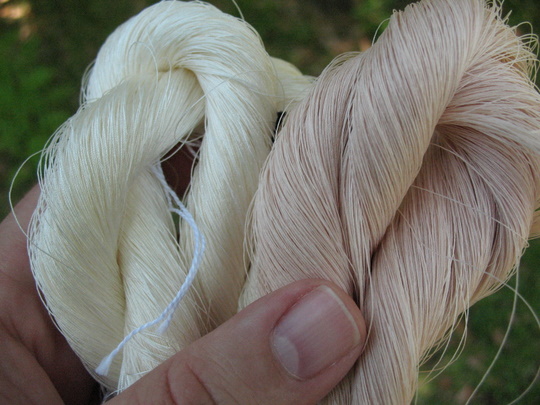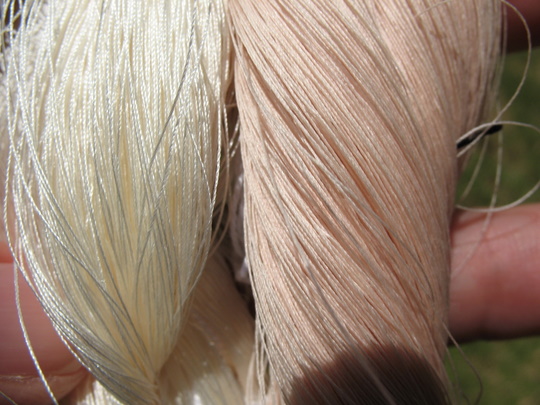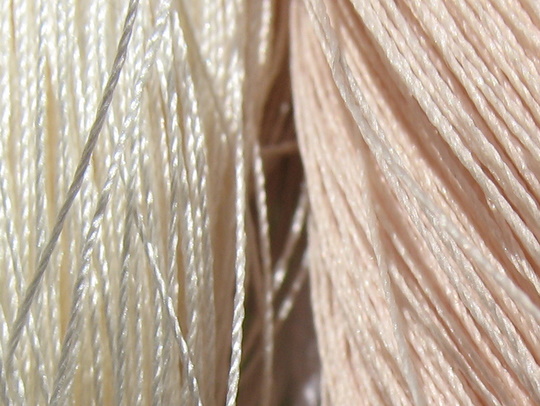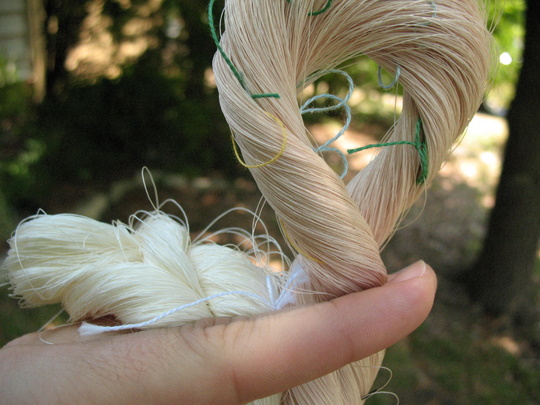Heminway thread

Before degumming, right, and after, left.
I got a great deal on some VERY fine thread. This stuff is Size 000 Silk Sewing Twist – normal, regular-fineness sewing thread is Size A, and it goes thicker up to F, and finer to 0, 00, and then this stuff. TINY.
The problem is – the thread is stiff, not very shiny, not really that attractive. I thought, “hmm… maybe it needs to be degummed.” I don’t know why anyone would sew with their thread raw, but that’s sure what this feels like. It could also be some sort of industrial coating – but if so, it made it feel like raw silk.
So, I decided to degum it. The difference is AMAZING. It’s exactly what I had hoped for. Next step is to dye this stuff, so I can weave with it.

You see, the thing that really caught my eye first, is that these are HUGE spools. Six and a half ounces of Size 000 silk is something like 8400 yards.
I bought a set of 4 spools first, and once I got it and confirmed that it was good quality and not rotten or shattered, I ordered three more. I should have plenty of fine silk for some time now.
This is what is referred to as “new old stock” – it’s never been used, and comes in the original wrapping tissue in a labeled box, but it is clearly forty or more years old. Sellers guess was that a code on the box might indicate 1960’s. Plastic spools and wrappings support that guess; it’s not ancient, but it’s not new.

See? 6.5 oz spools. Yum.
The problem was, once I wound some off, it was obvious that it was slightly dull, and very stiff. Felt like it might be raw. I decided to try degumming it – if it wouldn’t soften up, I could still use it, it just won’t be quite as sheeny or soft.

Here, you can see the before and after shot – degummed on the left, original on the right. I’m pretty sure this stuff was raw. I should have weighed it – silk will lose up to 25% of its weigh in degumming. But, the scale that will weigh that fine was put away, and I didn’t feel like digging it out.

Here, you can see the difference in color and texture.

Close up of the same shot. The difference in color really shows, as well as the difference in sheen.

Ooh, shiny!

This is the other main difference – and it was hard to figure out how to show it in a photo! I’m holding both of these skeins about three inches from the end. The degummed skein flops softly over my fingers – the raw skein stands up like starched linen.

Wow what a difference – you can really see it.
How peculiar getting gummed silk thread in the first place
Wow! That’s so beautiful now that you’ve treated it!
Wow, what an amazing find – and such a difference too!
I’m really thinking this might be bulk spools, like an intermediate part of the process – each of these spools would make 13 regular large “bulk” half-ounce spools of silk, or something like 80 of the dime-store size spools that most home sewers use. This looks like something that the silk factories would use for feeding the skeining and dyeing machines.
Could it be that it was left stiff on purpose so as to be easier to handle in whatever technique it was originally made to be used for, then washed out later?
The gummed skein definitely has a pinky color to it. Is that typical of natural silk gum?
Silk can come in that color, although I’m not sure if that’s natural for this particular silk.
I’m beginning to think that this might be an intermediate stage – like between the Twisting Machine and the Skeining machine. Each of these huge spools would make something like 13 bulk dressmaker’s spools (1/2 oz) and more like 80 to 150 of the regular size dime-store spools that home sewers use.
Aha
It reminds me of thin nylon cord!
Oh wow! It’s beautiful!
Where?
Can you share where you scored this? Or is it a deep dark secret?
Re: Where?
Oh, got it off Ebay. No big secret!
Gorgeous silk! You reminded me of a quote I read recently from a friend of mine… “Shiny is my favorite color!!”
What a find!
I’d be tempted to get greedy and order more…
Thanks for posting it to the Twist newsletter. I just couldn’t resist, and picked up some myself.